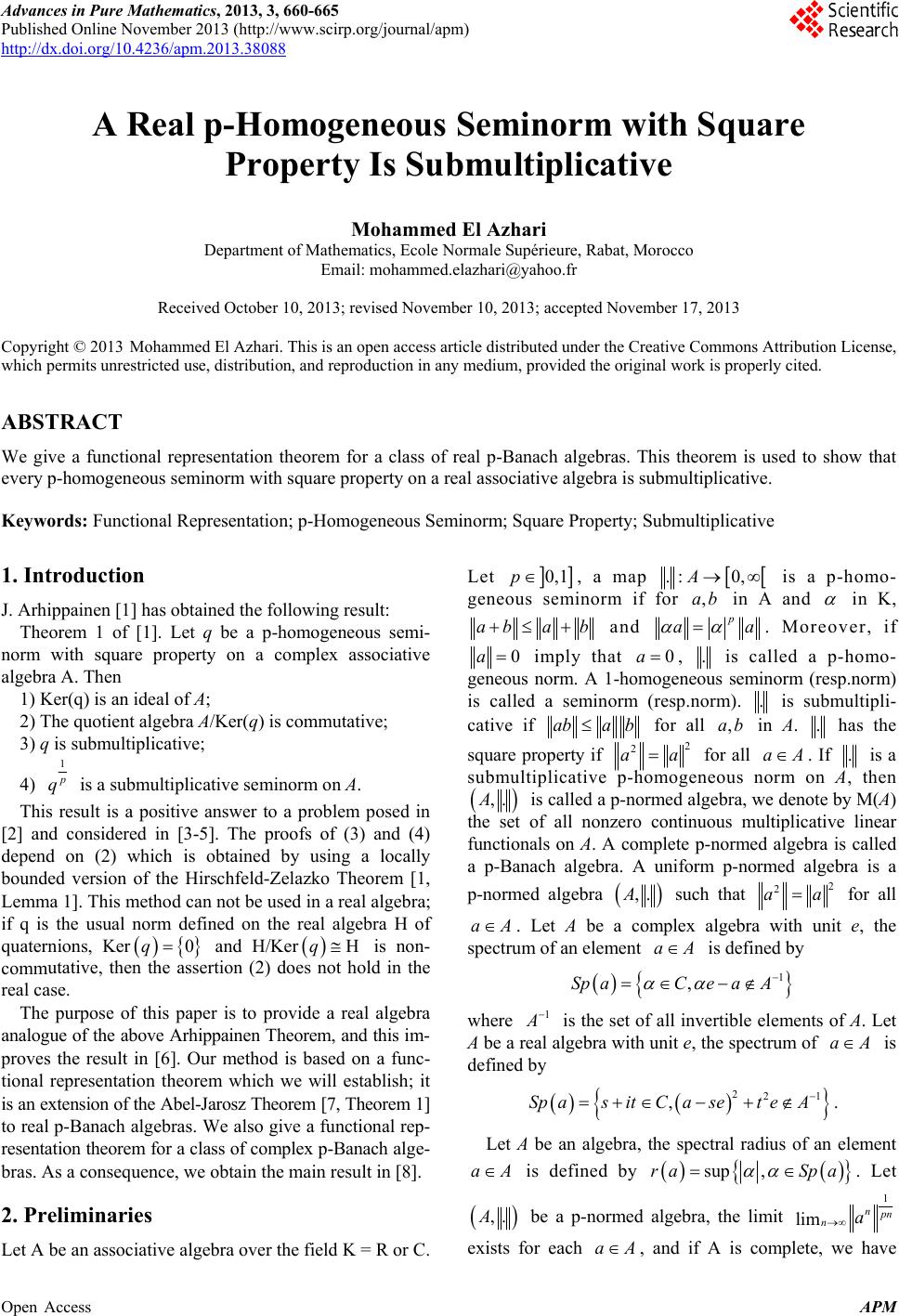 Advances in Pure Mathematics, 2013, 3, 660-665 Published Online November 2013 (http://www.scirp.org/journal/apm) http://dx.doi.org/10.4236/apm.2013.38088 Open Access APM A Real p-Homogeneous Seminorm with Square Property Is Submultiplicative Mohammed El Azhari Department of Mathematics, Ecole Normale Supérieure, Rabat, Morocco Email: mohammed.elazhari@yahoo.fr Received October 10, 2013; revised November 10, 2013; accepted November 17, 2013 Copyright © 2013 Mohammed El Azhari. This is an open access article distributed under the Creative Commons Attribution License, which permits unrestricted use, distribution, and reproduction in any medium, provided the original work is properly cited. ABSTRACT We give a functional representation theorem for a class of real p-Banach algebras. This theorem is used to show that every p-homogeneous seminorm with square property on a real associative algebra is submultiplicative. Keywords: Functional Representation; p-Homogeneous Seminorm; Square Property; Submultiplicative 1. Introduction J. Arhippainen [1] has obtained the following result: Theorem 1 of [1]. Let q be a p-homogeneous semi- norm with square property on a complex associative algebra A. The n 1) Ker(q) is an ideal of A; 2) The quotient algebra A/Ker(q) is commutative; 3) q is submultiplicative; 4) 1 q is a submultiplicative seminorm on A. This result is a positive answer to a problem posed in [2] and considered in [3-5]. The proofs of (3) and (4) depend on (2) which is obtained by using a locally bounded version of the Hirschfeld-Zelazko Theorem [1, Lemma 1]. This method can not be used in a real algebra; if q is the usual norm defined on the real algebra H of quaternions, Ker and H/Ker is non- commutative, then the assertion (2) does not hold in the real case. 0q Hq The purpose of this paper is to provide a real algebra analogue of the above Arhippainen Theorem, and this im- proves the result in [6]. Our method is based on a func- tional representation theorem which we will establish; it is an extens ion of the Abel-Jar osz Theore m [7 , Theore m 1] to real p-Banach algebras. We also give a functional rep- resentation theorem for a class of complex p-Banach a lg e- bras. As a consequence, we obtain the main result in [8]. 2. Preliminaries Let A be an associative algebra over the field K = R or C. Let 0,1p, a map .: 0,A is a p-homo- geneous seminorm if for in A and ,ab in K, aba b and p a a. Moreover, if 0a imply that 0a , . is called a p-homo- geneous norm. A 1-homogeneous seminorm (resp.norm) is called a seminorm (resp.norm). . is submultipli- cative if abab for all in A. ,ab . has the square property if 2 2 aa for all a. If A. is a submultiplicative p-homogeneous norm on A, then ,.A is called a p-normed algebra, we denote by M(A) the set of all nonzero continuous multiplicative linear functionals on A. A complete p-normed algebra is called a p-Banach algebra. A uniform p-normed algebra is a p-normed algebra ,.A such that 2 2 aa for all aA . Let A be a complex algebra with unit e, the spectrum of an element aA is defined by 1 ,Sp aCeaA where 1 is the set of all invertible elements of A. Let A be a real algebra with unit e, the spectrum of aA is defined by 221 ,SpasitCaseteA . Let A be an algebra, the spectral radius of an element aA is defined by sup ,ra Spa . Let ,.A be a p-normed algebra, the limit 1 lim n n na exists for each aA , and if A is complete, we have 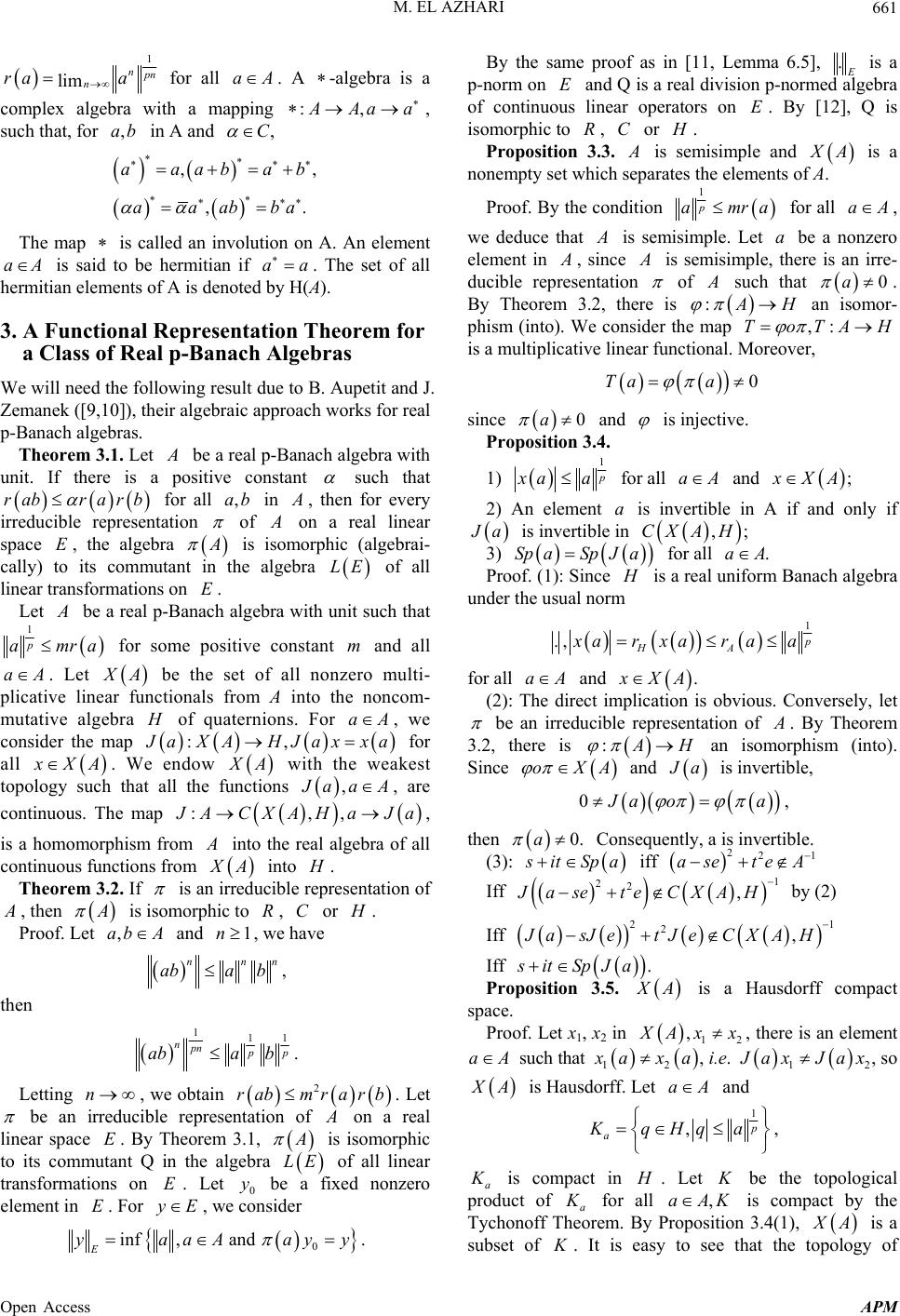 M. EL AZHARI 661 1 lim n n n ra a for all . A -algebra is a aA complex algebra with a mapping :, Aa a , such that, for in A and ,ab ,C ,, ,. aaabab aaabba The map is called an involution on A. An element is said to be hermitian if . The set of all hermitian elements of A is denoted by H(A). aAaa 3. A Functional Representation Theorem for a Class of Real p-Banach Algebras We will need the following result due to B. Aupetit and J. Zemanek ([9,10]) , th eir alg ebr aic approach works for real p-Banach algebras. Theorem 3.1. Let be a real p-Banach algebra with unit. If there is a positive constant such that for all in rab rarb ,ab , then for every irreducible representation of on a real linear space , the algebra E is isomorphic (algebrai- cally) to its commutant in the algebra of all linear transformations on . LE E Let be a real p-Banach algebra with unit such that 1 p amra for some positive constant and all m aA. Let A be the set of all nonzero multi- plicative linear functionals from A into the noncom- mutative algebra of quaternions. For aA , we consider the map :, aXAHJaxxa for all XA. We endow A with the weakest topology such that all the functions , aa A , are continuous. The map :,, ACXAH Jaa, is a homomorphism from into the real algebra of all continuous function s from A into . Theorem 3.2. If is an irreducible representation of , then is isomorphic to , or RC . Proof. Let and , we have ,ab A1n nn n aba b, then 111 npn p aba b. Letting , we obtain n 2 rab mrarb. Let be an irreducible representation of on a real linear space . By Theorem 3.1, E is isomorphic to its commutant Q in the algebra LE y of all linear transformations on . Let 0 be a fixed nonzero element in . For E E E, we consider 0 inf, and E yaaAay By the same proof as in [11, Lemma 6.5], . is a p-norm on and Q is a real div ision p-normed algebra of continuous linear operators on . By [12], Q is isomorphic to , or EE RC . Proposition 3.3. is semisimple and A is a nonempty set which separates the elements of A. Proof. By the condition 1 p amra for all aA , we deduce that is semisimple. Let be a nonzero element in a , since is semisimple, there is an irre- ducible representation of such that 0a . By Theorem 3.2, there is : H To an isomor- phism (into). We consider the map ,:TAH is a multiplicative linear functional. Moreover, 0Ta a since 0a and is injective. Proposition 3. 4. 1) 1 aa for all and aA ; XA 2) An element is invertible in A if and only if a a is invertible in ,;CXA H 3) aaASp aSpJ for all . Proof. (1): Since is a real uniform Banach algebra under the usual norm 1 ., HA arxa raa for all aA and . XA (2): The direct implication is obvious. Conversely, let be an irreducible representation of . By Theorem 3.2, there is : H an isomorphism (into). Since A oX and a is invertible, 0 ao a , then 0.a Consequently, a is invertible. (3): it Spa iff 221 aseteA Iff e 1 ,CXAH 22 Jaset by (2) Iff 21 2,JasJetJeCXA H Iff . itSp Ja Proposition 3.5. A is a Hausdorff compact space. Proof. Let x1, x2 in 1 ,2 Ax x, there is an element aA such that 12 axa, i.e. 12 ax Jax, so A is Hausdorff. Let and aA 1 ,p a KqHqa , y. a is compact in . Let be the topological product of a for all is compact by the Tychonoff Theorem. By Proposition 3.4(1), ,KaA A is a subset of . It is easy to see that the topology of Open Access APM 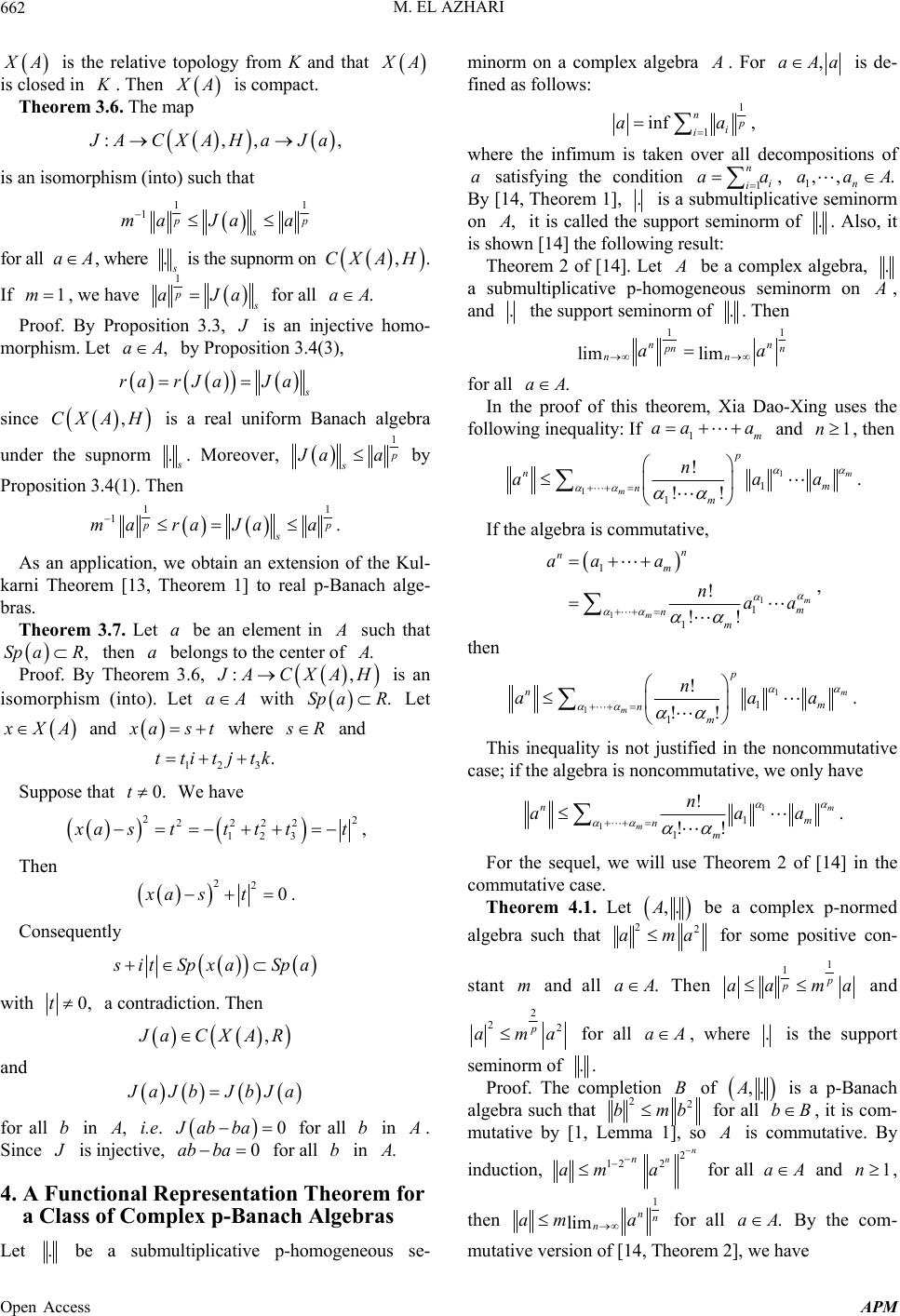 M. EL AZHARI 662 A is the relative topology from K and that A is closed in . Then K A :, is compact. Theorem 3.6. The m a p ,, AC HaJaXA is an isomorphism (into) such that 11 1 p s maaa J for all , where aA. is the supnorm on ,A H CX . If , we have 1m 1 p aJa for all .aA Proof. By Proposition 3.3, is an injective homo- morphism. Let by Proposition 3.4(3), ,aA ra rJaJa since is a real uniform Banach algebra A ,CXH under the supnorm . . Moreover, 1 s aa by Proposition 3.4(1). Then 11 1. p s mara Jaa As an application, we obtain an extension of the Kul- karni Theorem [13, Theorem 1] to real p-Banach alge- bras. Theorem 3.7. Let be an element in a such that then belongs to the center of Sp a,Ra. Proof. By Theorem 3.6, :, ACX A Sp aR AH is an isomorphism (into). Let a with Let . XA and ast where R and 12 3 .ttitjtk Suppose that We have 0.t 22 2 222 123 as ttttt, Then 220xa st. Consequently i tSpxaSpa with 0,t a contradiction. Then , aCXAR and aJb JbJa for all in b, i.e. for all b in 0Jab ba . Since is injective, for all b in 0 ab ba . 4. A Functional Representation Theorem for a Class of Complex p-Banach Algebras Let . be a submultiplicative p-homogeneous se- minorm on a complex algebra . For ,aAa is de- fined as follows: 1 inf n 1 i aa i A , where the infimum is taken over all decompositions of satisfying the condition 1 i, 1 an i aa,, . n aa By [14, Theorem 1], . is a submultiplicative seminorm on , it is called the support seminorm of .. Also, it is shown [14] the following result: Theorem 2 of [14]. Let be a complex algebra, . a submultiplicative p-homogeneous seminorm on , and . the support seminorm of .. Then 11 lim lim nn nn nn aa for all .aA In the proof of this theorem, Xia Dao-Xing uses the following inequality: If 1m aa a and , then 1n 1 11 1 ! !! m m p nm nm n aaa . If the algebra is commutative, 1 1 1 1 1 ! !! m m n nm m nm aaa naa , then 1 11 1 !. !! m m p nm nm n aa a This inequality is not justified in the noncommutative case; if the algebra is noncommutative, we only have 1 11 1 ! !! m m nm nm n aaa . For the sequel, we will use Theorem 2 of [14] in the commutative case. Theorem 4.1. Let ,.A be a complex p-normed algebra such that 22 ama for some positive con- stant and all .maA Then 1 1p p aa ma and 2 22 p ama for all aA , where . is the support seminorm of .. Proof. The completion of B ,.A is a p-Banach algebra such that 2 bmb2 for all b, it is com- mutative by [1, Lemma 1], so B is commutative. By induction, 2 122n n n am a for all a and , A1n then 1 lim nn n ama for all By the com- .aA mutative version of [14, Theorem 2], we have Open Access APM 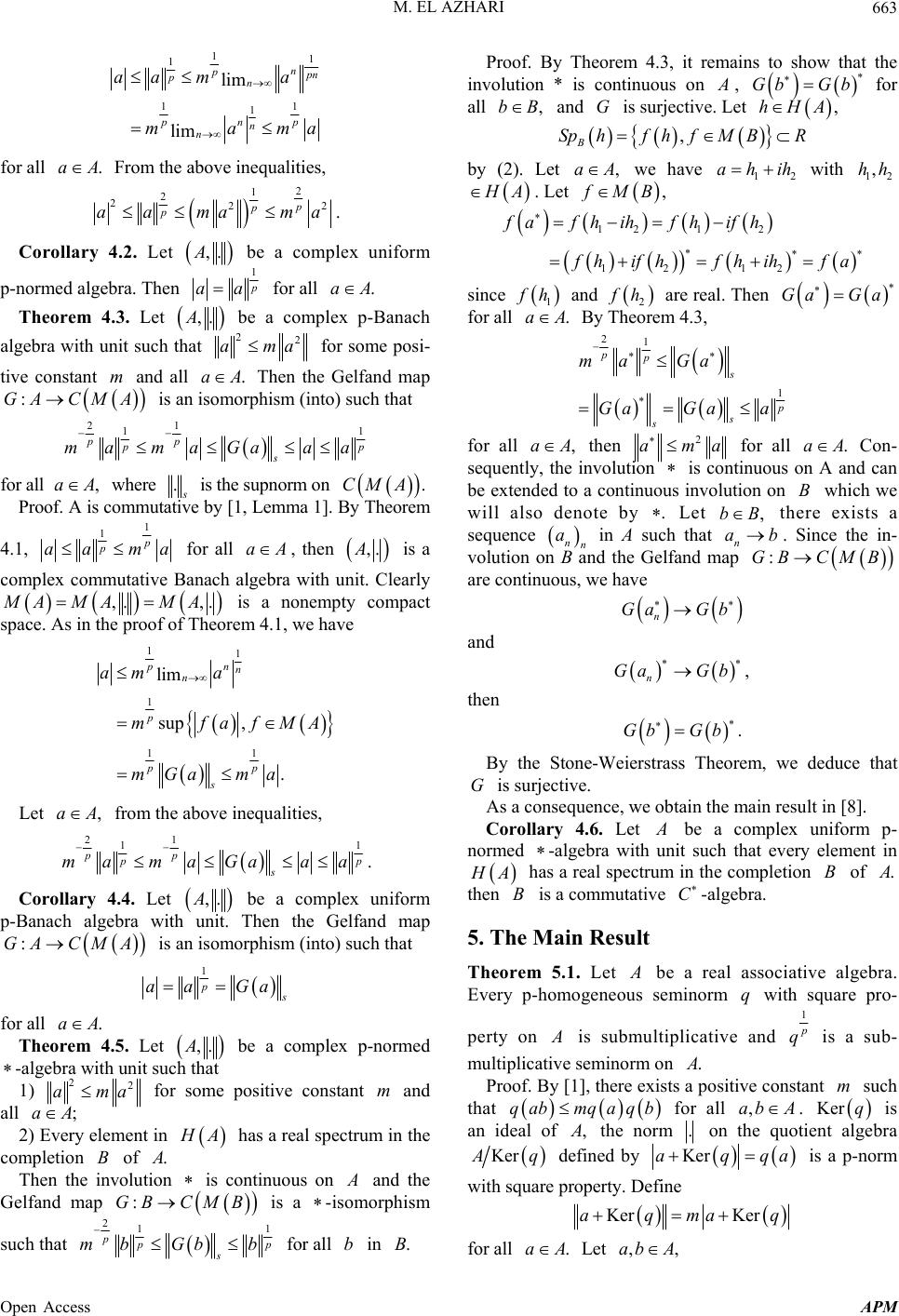 M. EL AZHARI 663 11 1 11 1 lim lim n p n pn n pp n n aa ma mam a for all . From the above inequalities, aA 2 1 2 222 p p p aa mama . Corollary 4.2. Let ,.A be a complex uniform p-normed algebra. Then 1 p aa for all .aA Theorem 4.3. Let ,.A be a complex p-Banach algebra with unit such that 22 ama for some posi- tive constant and all . Then the Gelfand map is an isomorphism (into) such that m MaA :GA CA 21 11 pp p s ma maGaaa for all where ,aA. is the supnorm on .CMA Proof. A is commutative by [1, Le mma 1]. By Theore m 4.1, 1 1p p aa ma for all , then aA ,.A is a complex commutative Banach algebra with unit. Clearly ,. ,. AMAMA is a nonempty compact space. As in the proof of Theorem 4.1, we have 11 1 11 lim sup , . n pn n p pp s am a mfafM mGa ma A Let from the above inequalities, ,aA 21 1 pp 1 p s ma maGaaa . Corollary 4.4. Let ,.A be a complex uniform p-Banach algebra with unit. Then the Gelfand map is an isomorphism (into) such that :GA CMA 1 p aa Ga for all . aA Theorem 4.5. Let ,.A be a complex p-normed -algebra with unit such that 1) 22 ama for some positive constant and all m ;aA 2) Every element in A has a real spectrum in the completion of . B Then the involution is continuous on and the Gelfand map :GB MB C is a -isomorphism such that 211 p p s mb Gbb for all in b.B Proof. By Theorem 4.3, it remains to show that the involution * is continuous on , Gb Gb for all ,bB and G is surjective. Let ,hHA , B Sphf hfM BR by (2). Let ,aA we have with 1 ahih 212 ,hh A. Let , MB 121 2 12 12 fafh ihfhifh hifhfh ihfa since 1 h and 2 h are real. Then GaGa for all .aA By Theorem 4.3, 21 1 pp s s s ma Ga GaGaa for all ,aA then 2 ama for all .aA Con- sequently, the involution is continuous on A and can be extended to a continuous involution on which we will also denote by B . Let there exists a sequence ,bB nn a in A such that n. Since the in- volution on B and the Gelfand map ab CMB:GB are continuous, we have n Ga Gb and , n Ga Gb then .Gb Gb By the Stone-Weierstrass Theorem, we deduce that is surjective. GAs a consequence, we obtain the main result in [8]. Corollary 4.6. Let be a complex uniform p- normed -algebra with unit such that every element in A has a real spectrum in the completion of B. then is a commutative -algebra. B C 5. The Main Result Theorem 5.1. Let be a real associative algebra. Every p-homogeneous seminorm with square pro- q perty on is submultiplicative and 1 q is a sub- multiplicative seminor m on . Proof. By [1], there exists a positive con stant such that m qabmqaqb for all . ,abA Kerq is an ideal of , the norm . on the quotient algebra Ker q defined by qKeraqa is a p-norm with square property . Define Ker Keraqmaq for all .aA Let ,,ab A Open Access APM 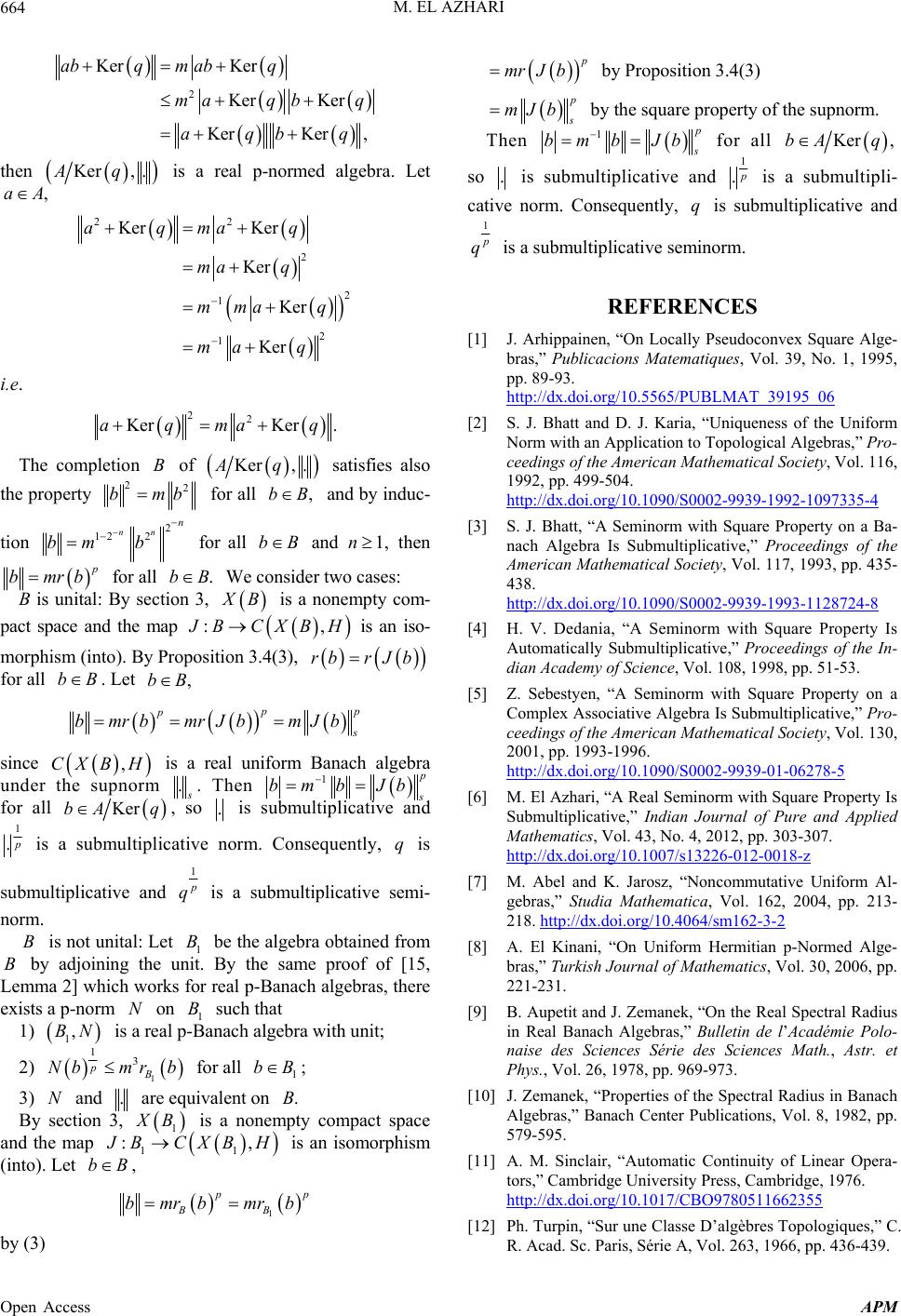 M. EL AZHARI 664 2 Ker Ker Ker Ker KerKer , ab qmab q ma qb q aqbq then Ker, .Aq is a real p-normed algebra. Let ,aA 22 2 2 1 2 1 Ker Ker Ker Ker Ker aqmaq ma q mmaq ma q i.e. 22 KerKer .aqma q The completion of B Ker, .Aq satisfies also the property 22 bmb for all and by induc- ,bB tion 2 12 2 nn n bm b for all and then bB1,n bmrb for all We consider two cases: . bB B is unital: By section 3, B : is a nonempty com- pact space and the map , BCXBH is an iso- morphism (into). By Proposition 3.4(3), rb rJb for all . Let bB, bB p p bmrb mrJbmJb since is a real uniform Banach algebra under the supnorm ,CXB H . . Then 1 bmb Jb for all KerbA q, so . is submultiplicative and 1 . is a submultiplicative norm. Consequently, is q submultiplicative and 1 q is a submultiplicative semi- norm. B is not unital: Let 1 be the algebra obtained from by adjoining the unit. By the same proof of [15, Lemma 2] which works for real p-Banach algebras, there exists a p-norm on such that B B B N1 1) is a real p-Banach algebra with unit; 1,BN 2) 1 13 pB Nbmr b for all ; 1 bB 3) and N. are equivalent o n .B By section 3, 1 B 1 : is a nonempty compact space and the map 1 , BCXBH bB is an isomorphism (into). Let , 1 p BB bmrbmrb by (3) mr J b by Proposition 3.4(3) mJb by the square property of the supnorm. Then 1 bmb Jb for all Ker ,bA q so . is submultiplicative and 1 . is a submultipli- cative norm. Consequently, is submultiplicative and q 1 q is a submultiplicative seminorm. REFERENCES [1] J. Arhippainen, “On Locally Pseudoconvex Square Alge- bras,” Publicacions Matematiques, Vol. 39, No. 1, 1995, pp. 89-93. http://dx.doi.org/10.5565/PUBLMAT_39195_06 [2] S. J. Bhatt and D. J. Karia, “Uniqueness of the Uniform Norm with an Application to Topological Algebras,” Pro- ceedings of the American Mathematical Society, Vol. 116, 1992, pp. 499-504. http://dx.doi.org/10.1090/S0002-9939-1992-1097335-4 [3] S. J. Bhatt, “A Seminorm with Square Property on a Ba- nach Algebra Is Submultiplicative,” Proceedings of the American Mathematical Society, Vol. 117, 1993, pp. 435- 438. http://dx.doi.org/10.1090/S0002-9939-1993-1128724-8 [4] H. V. Dedania, “A Seminorm with Square Property Is Automatically Submultiplicative,” Proceedings of the In- dian Academy of Science, Vol. 108, 1998, pp. 51-53. [5] Z. Sebestyen, “A Seminorm with Square Property on a Complex Associative Algebra Is Submultiplicative,” Pro- ceedings of the American Mathematical Society, Vol. 130, 2001, pp. 1993-1996. http://dx.doi.org/10.1090/S0002-9939-01-06278-5 [6] M. El Azhari, “A Real Seminorm with Square Property Is Submultiplicative,” Indian Journal of Pure and Applied Mathematics, Vol. 43, No. 4, 2012, pp. 303-307. http://dx.doi.org/10.1007/s13226-012-0018-z [7] M. Abel and K. Jarosz, “Noncommutative Uniform Al- gebras,” Studia Mathematica, Vol. 162, 2004, pp. 213- 218. http://dx.doi.org/10.4064/sm162-3-2 [8] A. El Kinani, “On Uniform Hermitian p-Normed Alge- bras,” Turkish Journal of Mathematics, Vol. 30, 2006, pp. 221-231. [9] B. Aupetit and J. Ze manek, “On the Real Spectral Radius in Real Banach Algebras,” Bulletin de l’Académie Polo- naise des Sciences Série des Sciences Math., Astr. et Phys., Vol. 26, 1978, pp. 969-973. [10] J. Zemanek, “Properties of the Spectral Radius in Banach Algebras,” Banach Center Publications, Vol. 8, 1982, pp. 579-595. [11] A. M. Sinclair, “Automatic Continuity of Linear Opera- tors,” Cambridge University Press, Cambridge, 1976. http://dx.doi.org/10.1017/CBO9780511662355 [12] Ph. Turpin, “Sur une Classe D’algèbres Topologiques,” C. R. Acad. Sc. Paris, Série A, Vol. 263, 1966, pp. 436-439. Open Access APM 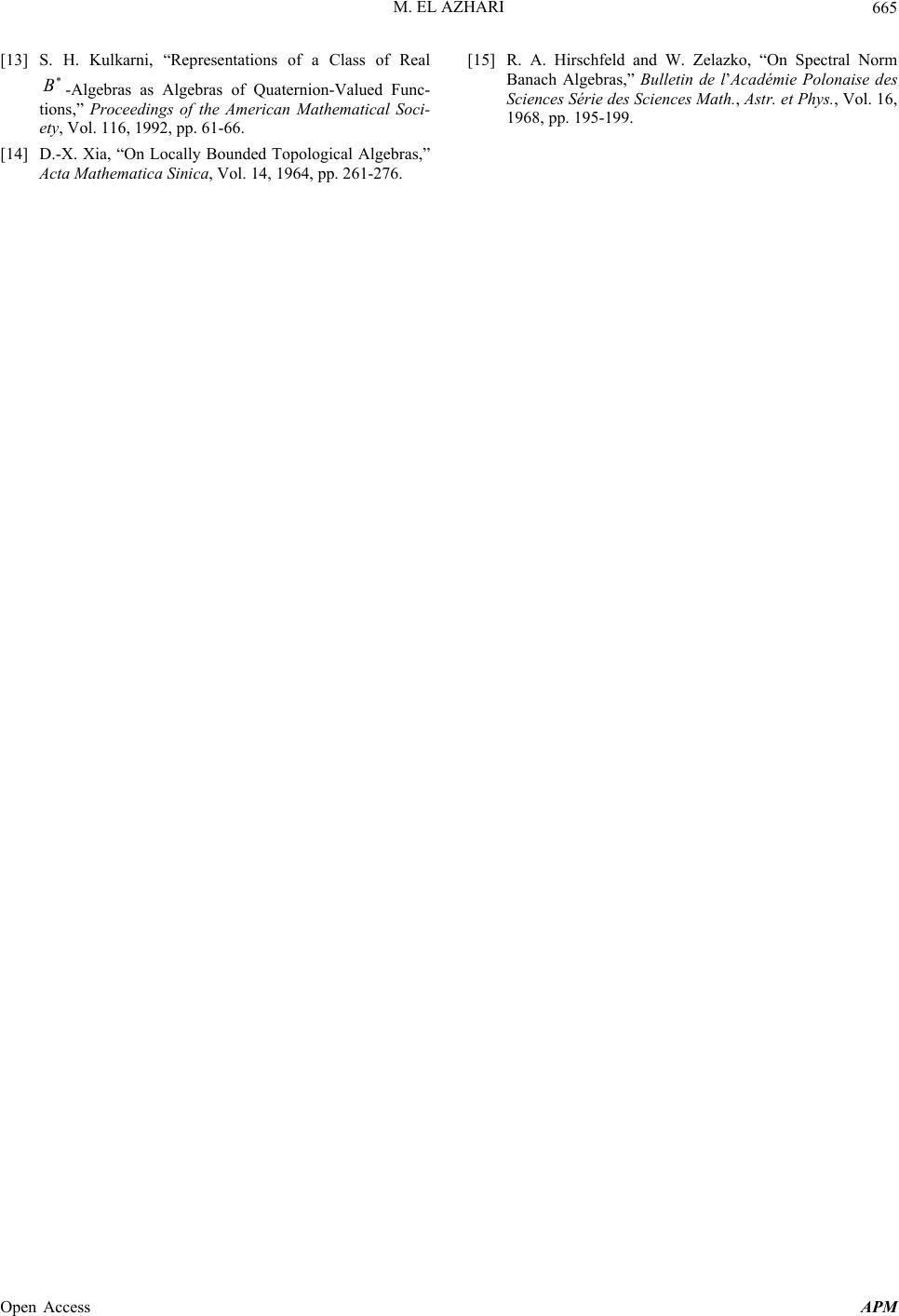 M. EL AZHARI Open Access APM 665 [15] R. A. Hirschfeld and W. Zelazko, “On Spectral Norm Banach Algebras,” Bulletin de l’Académie Polonaise des Sciences Série des Sciences Math., Astr. et Phys., Vol. 16, 1968, pp. 195-199. [13] S. H. Kulkarni, “Representations of a Class of Real B-Algebras as Algebras of Quaternion-Valued Func- tions,” Proceedings of the American Mathematical Soci- ety, Vol. 116, 1992, pp. 61-66. [14] D.-X. Xia, “On Locally Bounded Topological Algebras,” Acta Mathematica Sinica, Vol. 14, 1964, pp. 261-276.
|